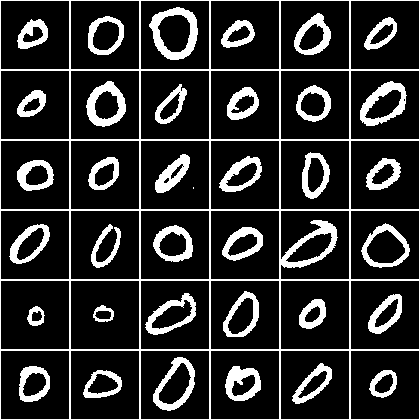Methods and Theory : Congealing Binary Images
Overview
Congealing, an algorithm for jointly aligning a set of images, was first developed for binary images. In particular, Learned-Miller showed how the variability of a set of handwritten digits from the same class, such as a set of zeroes, could be factored so that the variations among the images were explained by two types of variability--the variability due to affine transformation and the remaining variability--by jointing aligning a set of images. This allowed him to separately consider the types of variability which all handwritten characters share (which is closer to the affine type of variability), and the type which is character-specific, such as whether a two has a loop or not at the base. This in turn allowed the development of hand-written models of characters from a single example (see CVPR 2000 paper below).
Try moving your mouse over the images of handwritten zeroes below. As you do, the results of the congealing are shown. Notice that the zeroes have been "normalized" to be much more similar to each other.

Faculty
Collaborators
Publications
- Erik Miller, Nick Matsakis, and Paul Viola.
Learning from one example through shared densities on transforms.
Proceedings of the IEEE Conference on Computer Vision and Pattern Recognition (CVPR), Volume 1, pp. 464-471, 2000.
[pdf] - Erik Learned-Miller.
Data driven image models through continuous joint alignment.
In IEEE Transactions on Pattern Analysis and Machine Intelligence (PAMI), 28:2, pp. 236-250, 2006.
[pdf]
